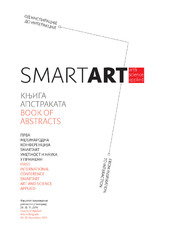Design Principles for Achieving Interior Spatiality
Abstract
Achieving spatiality is one of the essential topics in designing the ambience in which a certain
visual effect can be carried out or a higher level of spatial comfort obtained. The methods
relied on to achieve this are various: from shaping the physical boundaries of space by
use of open plan, flexibility, enfilade or circular connection, partial, directed or complete
opening of space towards its surroundings, up to application of some of the optical illusions
that redefine the experience of space boundaries. Depending on the method used,
spatial contours can be clearly defined or more or less obvious, or a space can be formed,
which does not reveal all its qualities through static observation, inviting the viewers to pass
through it in order to fully perceive it. If there is a lack of physical possibilities, and also as
an addition to previous methods, it is also possible to change the perceptive image of the
space through virtual build-up with the help of some of the optica...l illusions.
The aim of this paper is systematization and critical examination of basic designers’
principles which, in the domain of organization, shaping or materialization of the interior,
achieve a higher level of spatiality.
Keywords:
architecture / interior / space / spatiality / design principlesSource:
Book of Abstracts from the First International Conference SmartArt - Art and Science Applied, 2019, 18-18Publisher:
- Belgrade : Faculty of Applied Arts, University of Arts in Belgrade, Serbia
Funding / projects:
- Spatial, environmental, energy and social aspects of developing settlements and climate change - mutual impacts (RS-MESTD-Technological Development (TD or TR)-36035)
Collections
Group
RAUmPlanTY - CONF AU - Alfirević, Đorđe AU - Simonović Alfirević, Sanja PY - 2019 UR - http://raumplan.iaus.ac.rs/handle/123456789/688 AB - Achieving spatiality is one of the essential topics in designing the ambience in which a certain visual effect can be carried out or a higher level of spatial comfort obtained. The methods relied on to achieve this are various: from shaping the physical boundaries of space by use of open plan, flexibility, enfilade or circular connection, partial, directed or complete opening of space towards its surroundings, up to application of some of the optical illusions that redefine the experience of space boundaries. Depending on the method used, spatial contours can be clearly defined or more or less obvious, or a space can be formed, which does not reveal all its qualities through static observation, inviting the viewers to pass through it in order to fully perceive it. If there is a lack of physical possibilities, and also as an addition to previous methods, it is also possible to change the perceptive image of the space through virtual build-up with the help of some of the optical illusions. The aim of this paper is systematization and critical examination of basic designers’ principles which, in the domain of organization, shaping or materialization of the interior, achieve a higher level of spatiality. PB - Belgrade : Faculty of Applied Arts, University of Arts in Belgrade, Serbia C3 - Book of Abstracts from the First International Conference SmartArt - Art and Science Applied T1 - Design Principles for Achieving Interior Spatiality SP - 18 EP - 18 UR - https://hdl.handle.net/21.15107/rcub_raumplan_688 ER -
@conference{
author = "Alfirević, Đorđe and Simonović Alfirević, Sanja",
year = "2019",
abstract = "Achieving spatiality is one of the essential topics in designing the ambience in which a certain
visual effect can be carried out or a higher level of spatial comfort obtained. The methods
relied on to achieve this are various: from shaping the physical boundaries of space by
use of open plan, flexibility, enfilade or circular connection, partial, directed or complete
opening of space towards its surroundings, up to application of some of the optical illusions
that redefine the experience of space boundaries. Depending on the method used,
spatial contours can be clearly defined or more or less obvious, or a space can be formed,
which does not reveal all its qualities through static observation, inviting the viewers to pass
through it in order to fully perceive it. If there is a lack of physical possibilities, and also as
an addition to previous methods, it is also possible to change the perceptive image of the
space through virtual build-up with the help of some of the optical illusions.
The aim of this paper is systematization and critical examination of basic designers’
principles which, in the domain of organization, shaping or materialization of the interior,
achieve a higher level of spatiality.",
publisher = "Belgrade : Faculty of Applied Arts, University of Arts in Belgrade, Serbia",
journal = "Book of Abstracts from the First International Conference SmartArt - Art and Science Applied",
title = "Design Principles for Achieving Interior Spatiality",
pages = "18-18",
url = "https://hdl.handle.net/21.15107/rcub_raumplan_688"
}
Alfirević, Đ.,& Simonović Alfirević, S.. (2019). Design Principles for Achieving Interior Spatiality. in Book of Abstracts from the First International Conference SmartArt - Art and Science Applied Belgrade : Faculty of Applied Arts, University of Arts in Belgrade, Serbia., 18-18. https://hdl.handle.net/21.15107/rcub_raumplan_688
Alfirević Đ, Simonović Alfirević S. Design Principles for Achieving Interior Spatiality. in Book of Abstracts from the First International Conference SmartArt - Art and Science Applied. 2019;:18-18. https://hdl.handle.net/21.15107/rcub_raumplan_688 .
Alfirević, Đorđe, Simonović Alfirević, Sanja, "Design Principles for Achieving Interior Spatiality" in Book of Abstracts from the First International Conference SmartArt - Art and Science Applied (2019):18-18, https://hdl.handle.net/21.15107/rcub_raumplan_688 .



